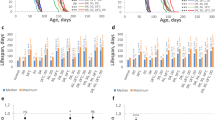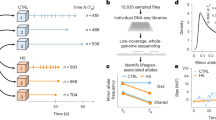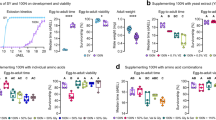Abstract
The developmental theory of ageing predicts a positive correlation between developmental time and adult longevity. Experiments that vary larval density and food level have been carried out to test this prediction. The results show differences in viability, developmental time, starvation resistance and adult longevity. It is concluded that pre-adult developmental time is not a causal factor for the determination of adult longevity in Drosophila melanogaster. The observed variation in adult longevity is discussed in relation to viability selection and changed adult physiology.
Similar content being viewed by others
Article PDF
References
Arking, R. 1987. Successful selection for increased longevity in Drosophila: analysis of the survival data and presentation of a hypothesis on the genetic regulation of longevity. Exp Geront, 22, 199–220.
Barker, K. 1961. An analysis of factors which determine success in competition for food among larvae of Drosophila melanogaster. Arch Need Zool, 14, 200–281.
Barker, J S F, and Podger, R N. 1970. Interspecific competition between Drosophila melanogaster and Drosophila simulons: effects of larval density on viability, developmental period and adult body weight. Ecology, 51, 170–189.
Boulétreau-Merle, J. 1988. Biological factors. In: Lints, F. A. and Soliman, M. H. (eds) Drosophila as a Model Organism for Ageing Studies, Blackie, London, pp. 85–96.
David, J R, Cohet, Y, and Fouillet, P. 1971. Ralentissement de la croissance et longévité des drosophiles adultes: influence d'une sous alimentation larvaire. C R Soc Biol, 165, 2110–2112.
David, J R, Cohet, Y, and Fouillet, P. 1975a. Physiologie de l'inanition et utilisation des réserves chez les adultes de Drosophila melanogaster. Arch Zool Exp, 116, 579–590.
David, J R, Cohet, Y, and Fouillet, P. 1975b. La résistance à l'inanition chez les insectes: importance de la quantité des réserves lipidiques chez les adultes de Drosophila melanogaster. C R Acad Sci Paris, 280, 2571–2574.
David, J R, Allemand, R, Van Herrewege, J, and Cohet, Y. 1983. Ecophysiology:abiotic factors. In: Ashburner, M., Carson, H. L. and Thompson, J. N. (eds) The Genetics and Biology of Drosophila, vol. 3d, Academic Press, London, pp. 105–170.
Economos, A C, and Lints, F A. 1984a. Growth rate and lifespan in Drosophila. I. Methods and mechanisms of variation of growth rate. Mech Age Dev, 27, 1–13.
Economos, A C, and Lints, F A. 1984b. Growth rate and lifespan in Drosophila. II. A biphasic relationship between growth rate and life-span. Mech Age Dev, 27, 143–151.
Economos, A C, and Lints, F A. 1986. Developmental temperature and life-span in Drosophila melanogaster. I. Constant developmental temperature: evidence for physiological adaptation in a wide temperature range. Gerontology, 32, 18–27.
Fairbanks, L D, and Burch, G E. 1970. Rate of water loss and water and fat content of adult Drosophila melanogaster of different ages. J Insect Physiol, 16, 1429–1436.
Fairbanks, L D, and Burch, G E. 1974. Changes with age in the ability of adult Drosophila melanogaster to respond to yeast feeding. Physiol Zool, 47, 190–197.
Finney, D J. 1947. Probit Analysis. Cambridge Academic Press, Cambridge.
Geer, B W, Olander, R M, and Sharp, P L. 1970. Quantification of dietary choline utilization in adult Drosophila melanogaster by radioisotope methods. J Insect Physiol, 16, 33–43.
Kirkland, J L. 1989. Evolution and ageing. Genome, 31, 398–405.
Lints, F A. 1978. Genetics and Ageing. Interdisciplinary Topics in Gerontology, Karger, Basel.
Lints, F A. 1985. Insects. In: Finch, C. E. and Schneider, E. L. (eds) Handbook of the Biology of Ageing, Van Nostrand Reinhold Company, New York, pp. 146–169.
Lints, F A. 1988. Genetics. In: Lints, F. A. and Soliman, M. H. (eds) Drosophila as a Model Organism for Ageing Studies, Blackie, London, pp. 99–118.
Lints, F A, and Lints, C V. 1969. Influence of preimaginal environment on fecundity and ageing in Drosophila melanogaster hybrids. I. Preimaginal population density. Exp Geront, 4, 231–244.
Lints, F A, and Lints, C V. 1971a. Influence of preimaginal environment on fecundity and ageing in Drosophila melanogaster hybrids. III. Developmental speed and lifespan. Exp Geront, 6, 427–445.
Lints, F A, and Lints, C V. 1971b. Relationship between growth and ageing in Drosophila. Nature New Biol, 229, 86–87.
Luckinbill, L A, and Clare, M J. 1985. Selection for life-span in Drosophila melanogaster. Heredity, 55, 9–18.
Luckinbill, L S, and Clare, M J. 1986. A density threshold for the expression of longevity in Drosophila melanogaster. Heredity, 56, 329–335.
Mayer, P J, and Baker, G T. 1985. Genetic aspects of Drosophila as a model system of eukaryotic aging. Int Rev Cytol, 95, 61–102.
Medawar, P B. 1952. An Unsolved Problem of Biology H. K. Lewis, London.
Miller, R S, and Thomas, J L. 1958. The effects of larval crowding and body size on the longevity of adult Drosophila melanogaster. Ecology, 39, 118–125.
Muller, H J. 1963. Mechanisms of life-span shortening. In: Harris, R. J. C. (ed) Cellular Basis and Aetiology of Late Somatic Effects of Ionizing Radiation, Academic Press, New York, pp. 235–245.
Partridge, L. 1986. Sexual activity and life-span. In: Collatz, K. G. and Sohal, R. S. (eds) Insect Aging, Springer-Verlag, Berlin, pp. 45–54.
Prout, T, and McChesney, F. 1985. Competition among immatures affects their adult fertility: population dynamics. Am Nat, 126, 521–558.
Quintana, A, and Prevosti, A. 1990. Genetic and environmental factors in the resistance of Drosophila subobscura adults to high temperature shock. I. Breeding temperature and crowding. Theor Appl Genet, 79, 103–107.
Rose, M R. 1984. Laboratory evolution of postponed senescence in Drosophila melanogaster. Evolution, 38, 1004–1010.
Service, P M. 1987. Physiological mechanisms of increased stress resistance in Drosophila melanogaster selected for postponed senescence. Physiol Zool, 60, 321–326.
Service, P M. 1989. The effect of mating status on life-span, egg laying, and starvation resistance in Drosophila melanogaster in relation to selection on longevity. J Insect Physiol, 35, 447–452.
Service, P M, Hutchinson, E W, MacKinley, M D, and Rose, M R. 1985. Resistance to environmental stress in Drosophila melanogaster selected for postponed senescence. Physiol Zool, 58, 380–389.
Sokal, R R, and Rohlf, F J. 1969. Biometry W. H. Freeman and Company, San Francisco.
Williams, G C. 1957. Pleiotropy, natural selection and the evolution of senescence. Evolution, 11, 398–411.
Author information
Authors and Affiliations
Rights and permissions
About this article
Cite this article
Zwaan, B., Bijlsma, R. & Hoekstra, R. On the developmental theory of ageing. I. Starvation resistance and longevity in Drosophila melanogaster in relation to pre-adult breeding conditions. Heredity 66, 29–39 (1991). https://doi.org/10.1038/hdy.1991.4
Received:
Issue date:
DOI: https://doi.org/10.1038/hdy.1991.4
Keywords
This article is cited by
-
Detecting purging of inbreeding depression by a slow rate of inbreeding for various traits: the impact of environmental and experimental conditions
Heredity (2021)
-
Neglecting larval rearing conditions in Drosophila melanogaster can negatively impact research on ageing
Biogerontology (2021)
-
Integrative developmental ecology: a review of density-dependent effects on life-history traits and host-microbe interactions in non-social holometabolous insects
Evolutionary Ecology (2020)
-
An overview of two decades of diet restriction studies using Drosophila
Biogerontology (2019)
-
Larval crowding results in hormesis-like effects on longevity in Drosophila: timing of eclosion as a model
Biogerontology (2019)



